Inside the London landmark where they're trying to save the Earth
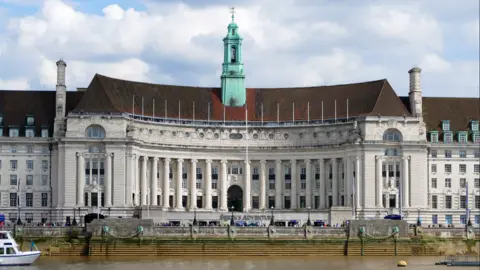 Getty Images
Getty ImagesUp on the fifth floor of London's County Hall, an enormous space which for decades echoed with the flapping wings of roosting pigeons is bustling with people meeting over cups of coffee and tapping away at laptops.
Built in the 1920s, the grand building opposite the Palace of Westminster on the Thames's South Bank was the home of the Greater London Council (GLC).
Until 1986, the offices and corridors were filled with those running local politics in the capital, but then the GLC was disbanded by Margaret Thatcher and the building was vacated.
Parts of it have since been redeveloped as tourist attractions, and the site contains two hotels. However, those people based up on the fifth floor have a very different purpose.
"We have a rule - if you're not solving climate change, you don't get in the building," explains Andrew Wordsworth, CEO and co-founder of Sustainable Ventures, which runs the space.
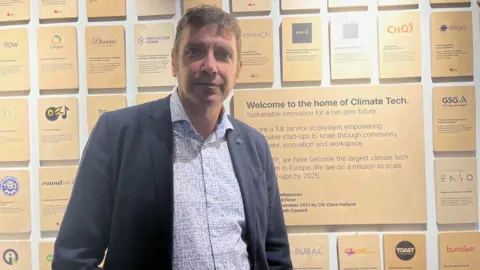
The firm was created in 2011 to help support climate-focused tech start-ups and moved into its County Hall base last year following a £6.5m renovation of the Grade II*-listed building.
It now claims to be home to Europe’s largest cluster of climate tech start-ups, with more than 120 firms based on the fifth floor and some 1,000 people working here.
"Everybody here has a common purpose. They're all doing different things, they're all looking at different sectors, but everybody has that common mission," Mr Wordsworth says.
While hints of the building's former 1920s life remain, with the old office dividers still visible within the original wood parquet floor, the interior now looks very different, reflecting the eco-tech work going on.
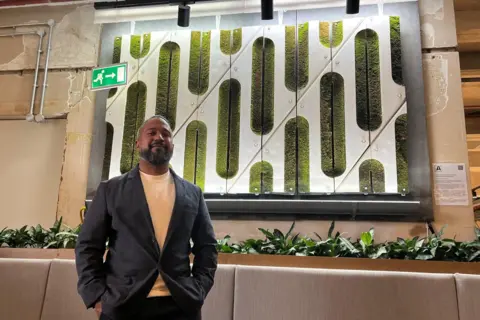
On the wall in the foyer is what looks like a large artwork, with curved strips of moss growing on a grey background above a drainpipe.
It may look like an unusual work of art but is actually a form of "living wall", absorbing pollutants from the room while also helping to cool the building, says Nick Naidu, founder and CEO of Alive Labs.
"There’s a real drive for 'green walls', but green walls are struggling with the challenge, they're just not quite succeeding. They're quite costly, they fail a lot of the time and so we saw that there's a real lack of innovation in this space."
His company therefore struck on the idea of using a different form of plant life.
"We're working with mosses because they're quite happy growing in the urban environment. They've evolved in London, they've survived through our industrialisation period so they're pretty robust," he says.
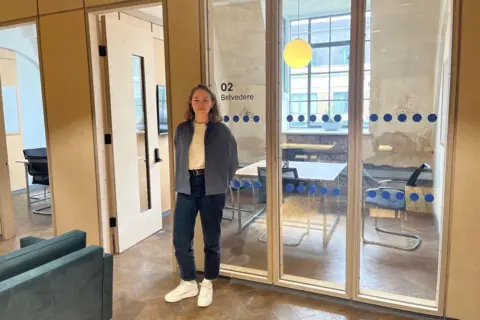
The company has been part of Sustainable Ventures for a number of years and like several others working with the firm, contributed to transforming the century-old interior.
Another is U-Build which created the industrial-looking office spaces, meeting pods and desks.
"It's all made out of plywood in this particular project, which makes it very sustainable as it's renewable material," explains Hannah Towler, who is an associate with the firm.
The system features large wooden panels that are bolted in place without having to be fixed to the concrete walls. It means they can be shifted and offices altered as needs change.
"We're really aware that the construction industry is particularly wasteful with its use of materials, or it can be. Office fit-outs contribute to a huge part of this and the average [office] tenancy is just two years and 10 months.
"The key is flexibility, being able to move things, adaptability," she says.
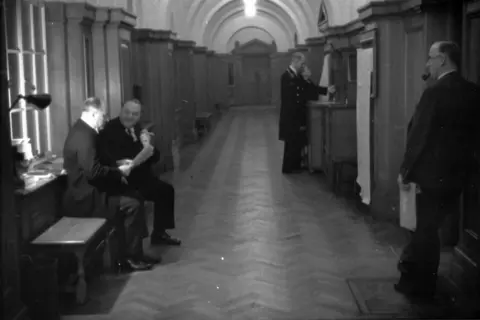 Getty Images
Getty Images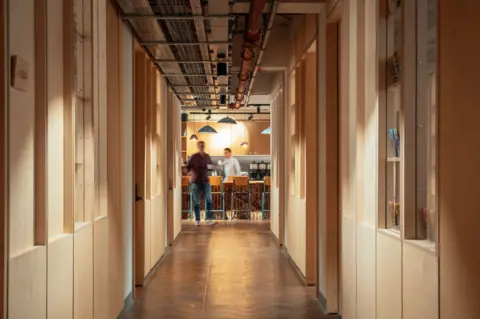 U-Build
U-BuildEven the toilets look - and sound - very different to those in the average office space, featuring clear lids that are made from the same material used for police riot shields.
The reason for this is because 120 litres of air is used to flush waste away into drains, cutting water use, says David Hollander, the chair of Propelair, which is behind the devices.
"Our toilets use about six or seven litres less water a flush, which saves the planet but it also saves Sustainable significant funds. It's a much cheaper way of running a toilet, that’s using less water."
He says the cost of the toilets makes them prohibitive for homes, with the firm marketing their devices in the commercial world.
"Like everyone else at Sustainable we believe in saving the planet and Propelair saves it one flush at a time."

Not all of the renovations have involved newly developed technology.
In the middle of the office kitchen beneath lampshades made from recycled coffee cups sits a bulky wooden table with the words "James Davies is a snake" carved into it among doodles, hearts and scribblings.
In its previous life this worktop was a chemistry bench at a school in Hertfordshire.
The meeting rooms and phone booths have also been soundproofed using airline uniforms once worn by KLM staff.
"It's great just bringing that to life and just showing that you when you're looking for building materials, actually reusing stuff can be as good as coming up with a really innovative product as well," Mr Wordsworth says.
"We've got over 70 different sustainable materials and techniques being used across the space."
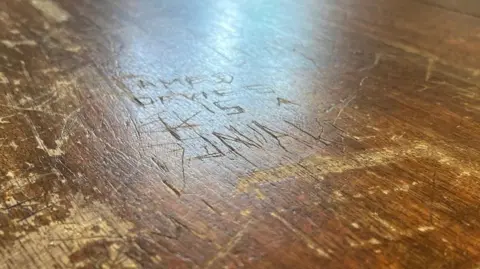
Mr Wordsworth says County Hall has proven a popular place for start-ups, with the space now 99% full.
"Our biggest problem is we're actually turning people away.
"We are looking at other spaces in County Hall to expand this space and then obviously building on the experience here to go into Manchester and Glasgow over the next couple of years."
He's also encouraged by the growth in firms working towards sustainability and tackling climate change.
"Ultimately, the world will run out of new materials and landfill sites and so on," he says.
"That's why we absolutely see in the long term as we move to a net-zero future, everything is going to have to be sustainable."
Listen to the best of BBC Radio London on Sounds and follow BBC London on Facebook, X and Instagram. Send your story ideas to [email protected]
